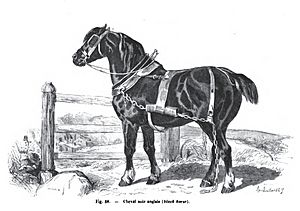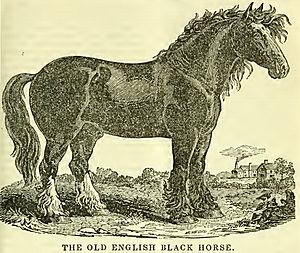Old English Black facts for kids
The Old English Black was a type of horse that lived a long time ago. It's also known as the Lincolnshire Black. Sadly, this horse breed is now extinct, meaning it no longer exists.
Contents
A Horse from History
How the Breed Started
The story of the Old English Black horse began a very long time ago, around the year 1066. This was when the Normans came to England. They brought strong "Great Horses" from Europe with them. These horses were then bred with the horses already living in England. Over many years, a special new type of horse developed. This horse became known as the Old English Black Horse.
What They Looked Like
Even though it was called the "Black" horse, this breed wasn't always black! For a long time, most of these horses were actually bay (a reddish-brown color) or brown. You could also find them in other colors like roan, grey, and chestnut.
They often had special markings on their legs and faces. Many had four white "stockings" (white markings on their lower legs) and a clear white stripe down their face, called a "bald face." These markings were quite similar to those seen on Clydesdale horses today.
The Lincolnshire Connection
Later, a king named William III brought large horses from Holland to England. These horses might have been related to the Brabant and Friesian breeds. He needed very strong horses to help drain the wet, marshy lands in an area called the Lincolnshire Fens. The horses already there weren't strong enough for this tough job. These new, powerful horses became known as the Lincolnshire Blacks.
The End of a Breed
Over time, the Old English Black Horse stopped being a separate breed. Its special features and bloodlines became mixed into other horse breeds.
A horse breeder named Robert Bakewell helped develop the Old English Black Horse into what was called the Black Horse of Leicestershire. This horse was an early version of the Shire horse, which is a very large and strong horse breed today.
The Old English Black Horse had a big impact on the Clydesdale and Shire breeds. Many of the features you see in these powerful horses today, like their strength and some of their looks, came from their Old English Black ancestors.



